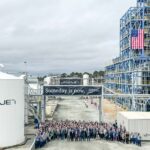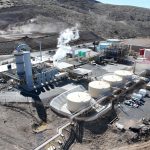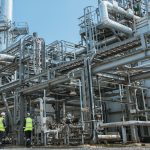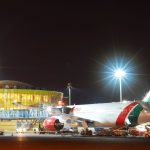The Freedom Pines facility has produced its first fuel after 15 years of development, said LanzaJet CEO Jimmy Samartzis, with backing from prominent international investors and financiers including Airbus, All Nippon Airways, Breakthrough Energy, British Airways, Groupe ADP, LanzaTech, Microsoft’s Climate Innovation Fund , Mitsui & Co, MUFG, Shell, Southwest Airlines, the US Department of Energy and the UK Department for Transport.
The new facility has capacity to produce up to 10 million gallons of fuel per year, and the company has announced offtake agreements extending into the next decade.
“With the bio-oil HEFA pathway expected to near a plateau in available and qualified feedstocks,” said the company, “LanzaJet’s proprietary ATJ technology has now unlocked the next wave of sustainable aviation fuel technology applicable to nearly all regions throughout the world, and urgently needed by the sector.
“Our flagship SAF plant will be the industry’s first commercial-scale ethanol-to-jet SAF plant. Its start up launches the next generation of SAF production across the world and is a leap forward for the industry.”
The achievement of first fuel production at Freedom Pines reflects “what happens when you bring together innovation, resilience, ingenuity and teamwork to think big and develop a new industry, overcome challenges and enable global growth,” added Samartzis.
“We’re now in a unique position with technology and operational know-how to shape this global industry in the decade ahead. This is an important milestone for LanzaJet and our investors, and it’s a major win for global aviation, perhaps serving as a beacon of hope for the future.”
His comments came as global pressure intensifies for greater funding support for renewable fuel projects, and as concerns increase across the air transport industry that decarbonisation targets might not be met.
The European Commission has just launched the Sustainable Transport Investment Programme (STIP) to urgently stimulate funding for renewable aviation and maritime fuels to help both sectors meet Europe’s own legislated decarbonisation targets.
The LanzaJet ATJ technology has been developed to convert a wide range of sustainable feedstocks, including agricultural residues, energy crops, municipal solid waste and captured carbon, to SAF or renewable diesel.
“Once blended with Jet A-1 fuel,” said the company, “the result is a fully certified solution compatible with existing aircraft and infrastructure. LanzaJet is delivering this technology throughout the world including the US, Australia, Japan, India, United Kingdom, Colombia, European Union, Middle East and Kazakhstan.”
The Freedom Pines milestone comes just weeks after LanzaJet selected global engineering and construction group Fluor Corporation to provide the Front End Engineering and Design (FEED) for Project Speedbird, a commercial-scale ethanol-to-SAF facility planned for Teesside, northeast England, and supported by British Airways.
The plant is being designed to produce more than 90,000 tonnes (30 million gallons) of SAF and renewable diesel per year, enough to reduce the airline’s CO2 emissions by an estimated 230,000 tonnes annually, roughly equivalent to 26,000 domestic flights in the UK.
“Project Speedbird is the next commercial-scale facility in our portfolio that LanzaJet is developing, working closely with British Airways,” said Samartzis. “It is an important step in the continued scale-up of our leading sustainable fuels technology.”
LanzaJet and KMG, the national oil and gas company of Kazakhstan, recently signed an agreement to progress that country’ first SAF production plant, and a first for LanzaJet in the Central Asia region.
The two companies recently concluded a joint feasibility study of the proposed ATJ project and agreed to progress to the next stage of development – Front End Engineering and Design – through which technical and economic solutions will be developed ahead of construction.
Photo: The formal opening of LanzaJet’s Freedom Pines Fuels refinery in January 2024

Tony Harrington
Correspondent















More News & Features
European Commission announces Sustainable Transport Investment Plan to advance low-and-no-carbon fuels
News Roundup October 2025
XCF plans three new Australian SAF plants, while Wagner and FlyOro activate blending facility
UK government starts new consultation on SAF revenue certainty mechanism
African Development Bank and Japanese industrialist unite to explore SAF production in Africa
Cirium analysis challenges assumptions between aviation growth and environmental impact